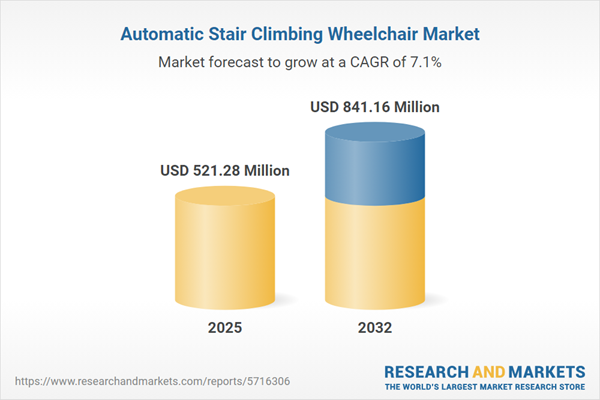Speak directly to the analyst to clarify any post sales queries you may have.
The automatic stair climbing wheelchair market is evolving swiftly, as mobility providers and healthcare leaders seek to deliver safer, more versatile, and accessible mobility solutions for diverse environments. This growth is propelled by technological innovation and urgent demand for inclusive design.
Market Snapshot: Automatic Stair Climbing Wheelchair Market
The automatic stair climbing wheelchair market grew from USD 486.02 million in 2024 to USD 521.28 million in 2025. It is expected to continue growing at a CAGR of 7.09%, reaching USD 841.16 million by 2032. This robust trajectory reflects increasing investment in advanced mobility, a response to demographic shifts, progressive regulatory standards, and rising expectations for universal accessibility.
Scope & Segmentation
This report provides a comprehensive breakdown of the market across multiple dimensions, equipping strategic leaders with a granular view of current opportunities, segmentation trends, and competitive considerations.
- Platform Types: Fixed platforms, foldable platforms
- Railing Configurations: Dual railing, single railing
- Drive Types: Front-wheel drive, mid-wheel drive, rear-wheel drive
- Applications: Indoor (commercial, residential), outdoor (rough terrain, urban)
- End Users: Home care, general hospitals, specialized hospitals, rehabilitation centers
- Distribution Channels: General dealers, specialized dealers, direct sales, online (company websites, third party)
- Price Ranges: Economy, mid-priced, premium
- Technology Variants: Joystick, voice control, AI-enabled navigation, advanced battery technology, infrared, pressure-based sensor mechanisms
- Regions: Americas (United States, Canada, Mexico, Brazil, Argentina, Chile, Colombia, Peru), Europe (United Kingdom, Germany, France, Russia, Italy, Spain, Netherlands, Sweden, Poland, Switzerland), Middle East (United Arab Emirates, Saudi Arabia, Qatar, Turkey, Israel), Africa (South Africa, Nigeria, Egypt, Kenya), Asia-Pacific (China, India, Japan, Australia, South Korea, Indonesia, Thailand, Malaysia, Singapore, Taiwan)
- Key Companies: WHILL, Inc., Scewo AG, Levo AG, Mobius Mobility, Inc., Mountain Trike Ltd, Pride Mobility Products Corp, Permobil AB, Sunrise Medical, Inc., Invacare Corporation
Key Takeaways for Senior Decision-Makers
- Automated stair climbing wheelchair solutions are increasingly integrating AI-driven controls and advanced sensor arrays, setting new operational benchmarks for safety and adaptability.
- Segmented offerings allow end users and care institutions to select solutions tailored to specific environments, such as urban public spaces or home healthcare settings.
- Modular design and upgrade paths are becoming critical, enabling long-term product relevance and more efficient asset management for care providers.
- Ongoing collaboration between established manufacturers, innovation-driven startups, and research institutions accelerates time-to-market and supports regulatory compliance.
- Multi-channel distribution approaches, especially online and direct sales, are reshaping procurement strategies and expanding reach to diverse customer profiles.
Tariff Impact: Implications for Sourcing and Cost Structures
The introduction of new United States tariffs in 2025 is expected to place upward pressure on core component costs, including electric motors, battery modules, and sensor technologies. As a response, manufacturers are adjusting procurement strategies by diversifying supplier portfolios, considering nearshoring, and negotiating with regional partners. These measures aim to protect margins and maintain supply chain agility, while mitigating the risks posed by changing trade policies. Operational resilience will depend on strategic sourcing, inventory management, and continuous evaluation of global supply chain dynamics.
Methodology & Data Sources
This research is grounded in a robust mixed-method approach. Primary data was collected through direct interviews with developers, procurement specialists, and clinicians, complemented by facility site visits and product demonstrations. Secondary data sources include peer-reviewed journals, industry reports, regulatory filings, and corporate disclosures, validated by triangulation and expert follow-up.
Why This Report Matters for Industry Leaders
- Provides actionable insights into technological shifts such as AI integration and sensor-enabled navigation that are redefining competition in the market.
- Equips stakeholders with strategic guidance on tariff navigation, supply chain resilience, and differentiated product development for long-term success.
Conclusion
This report delivers a holistic view of the automatic stair climbing wheelchair market, enabling decision-makers to identify priority growth areas and make informed investments. Effective strategies in innovation, regional adaptation, and supply chain management will be pivotal to sustained advancement in accessible mobility.
Additional Product Information:
- Purchase of this report includes 1 year online access with quarterly updates.
- This report can be updated on request. Please contact our Customer Experience team using the Ask a Question widget on our website.
Table of Contents
3. Executive Summary
4. Market Overview
7. Cumulative Impact of Artificial Intelligence 2025
Companies Mentioned
The companies profiled in this Automatic Stair Climbing Wheelchair market report include:- WHILL, Inc.
- Scewo AG
- Levo AG
- Mobius Mobility, Inc.
- Mountain Trike Ltd
- Pride Mobility Products Corp
- Permobil AB
- Sunrise Medical, Inc.
- Invacare Corporation
Table Information
| Report Attribute | Details |
|---|---|
| No. of Pages | 188 |
| Published | October 2025 |
| Forecast Period | 2025 - 2032 |
| Estimated Market Value ( USD | $ 521.28 Million |
| Forecasted Market Value ( USD | $ 841.16 Million |
| Compound Annual Growth Rate | 7.0% |
| Regions Covered | Global |
| No. of Companies Mentioned | 10 |









